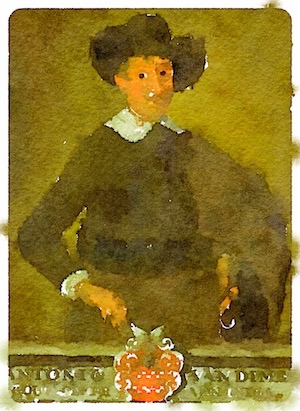
The energetic Dutch colonial administrator and governor-general of the Dutch East Indies Anthony van Diemen (1593 – 19 April 1645) consolidated the Dutch interests in Southeast Asia.
He was born in Culemborg and moved to Amsterdam in 1616, His business career there proved disastrous, and after being declared bankrupt, he joined the Dutch East India Company (VOC) under an assumed name and sailed to Batavia.
On the ground in the Indies van Diemen's fortunes changed for the better, Governor-General Jan Pieterszoon Coen found him to be a talented administrator and appointed him Director-General of Commerce in 1626. The appointment also delivered a seat on the Council for the Indies.
He married in 1630, returned to the Netherlands as Admiral on the Deventer the following year and was back in Batavia by the end of 1632
Three years later he was appointed Governor-General of the Dutch East Indies, with the appointment taking effect on 1 January 1636.
Van Diemen's term as Governor-General delivered a significant expansion of Dutch interests across South-East Asia. A treaty with the sultan of Ternate in 1638 gave the Dutch a monopoly in the spice trade in the Moluccas and freed the company's military resources for a war of conquest (1638–43) that saw Dutch power established in Sri Lanka with additional trading posts on India’s Coromandel Coast.
In 1641 van Diemen's forces seized the Portuguese stronghold in Malacca and drove the Spanish out of Formosa (Taiwan). Advantageous treaties with Aceh and Tidore strengthened the Dutch position, along with commercial arrangements with Tonkin (Vietnam) and Japan. By the end of van Diemen’s nine-year administration, the Netherlands were the paramount commercial and political power in island Southeast Asia.
Van Diemen's efforts to foster exploration delivered mixed results. He sent out his first exploratory voyage within three months of his arrival in Batavia directing Gerrit Thomasz Pool and Pieter Pieterzoon towards Cape York to chart the unknown coasts, but the venture only managed to get as far as New Guinea, where natives killed the commander, and the ships turned back.
A two-ship expedition under Matthijs Quast which set sail to locate the "Gold and Silver Islands" that were believed to lie east of Japan in June 1639 and Maarten Gerritsz Vries was sent to explore the coasts of Korea and "Tartaria". Both returned with nothing noteworthy to report.
Frans Visscher and Abel Janszoon Tasman set out in search of the Great South Land, in November 1642, running east from Mauritius on latitude 44S. While they missed the south coast of the continent, Tasman sighted the west coast of Tasmania, followed the coastline around to the east coast and sent a party to land on the Tasman Peninsula before proceeding on to New Zealand, Tonga, the Fijian islands and back to Batavia around the top of New Guinea. Tasman's second expedition charted Australia's northern coast in 1644 but failed to deliver anything of strategic or commercial interest.
Van Diemen died in Batavia in 1645.